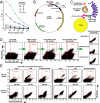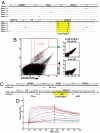High-affinity lamprey VLRA and VLRB monoclonal antibodies
- PMID: 19625627
- PMCID: PMC2722331
- DOI: 10.1073/pnas.0904443106
High-affinity lamprey VLRA and VLRB monoclonal antibodies
Abstract
Lamprey are members of the ancestral vertebrate taxon (jawless fish), which evolved rearranging antigen receptors convergently with the jawed vertebrates. But instead of Ig superfamily domains, lamprey variable lymphocyte receptors (VLRs) consist of highly diverse leucine-rich repeats. Although VLRs represent the only known adaptive immune system not based on Ig, little is known about their antigen-binding properties. Here we report robust plasma VLRB responses of lamprey immunized with hen egg lysozyme and beta-galactosidase (beta-gal), demonstrating adaptive immune responses against soluble antigens. To isolate monoclonal VLRs, we constructed large VLR libraries from antigen-stimulated and naïve animals in a novel yeast surface-display vector, with the VLR C-terminally fused to the yeast Flo1p surface anchor. We cloned VLRB binders of lysozyme, beta-gal, cholera toxin subunit B, R-phycoerythrin, and B-trisaccharide antigen, with dissociation constants up to the single-digit picomolar range, equivalent to those of high-affinity IgG antibodies. We also isolated from a single lamprey 13 anti-lysozyme VLRA clones with affinities ranging from low nanomolar to mid-picomolar. All of these VLRA clones were closely related in sequence, differing at only 15 variable codon positions along the 244-residue VLR diversity region, which augmented antigen-binding affinity up to 100-fold. Thus, VLRs can provide a protective humoral antipathogen shield. Furthermore, the broad range of nominal antigens that VLRs can specifically bind, and the affinities achieved, indicate a functional parallelism between LRR-based and Ig-based antibodies. VLRs may be useful natural single-chain alternatives to conventional antibodies for biotechnology applications.
Conflict of interest statement
The authors declare no conflict of interest.
Figures



References
-
- Batista FD, Neuberger MS. Affinity dependence of the B cell response to antigen: A threshold, a ceiling, and the importance of off-rate. Immunity. 1998;8:751–759. - PubMed
-
- Pancer Z, et al. Somatic diversification of variable lymphocyte receptors in the agnathan sea lamprey. Nature. 2004;430:174–180. - PubMed
-
- Alder MN, et al. Diversity and function of adaptive immune receptors in a jawless vertebrate. Science. 2005;310:1970–1973. - PubMed
Publication types
MeSH terms
Substances
Associated data
- Actions
- Actions
- Actions
- Actions
- Actions
- Actions
- Actions
- Actions
- Actions
- Actions
- Actions
- Actions
- Actions
- Actions
- Actions
- Actions
- Actions
- Actions
- Actions
- Actions
- Actions
- Actions
- Actions
- Actions
Grants and funding
LinkOut - more resources
Full Text Sources
Other Literature Sources

